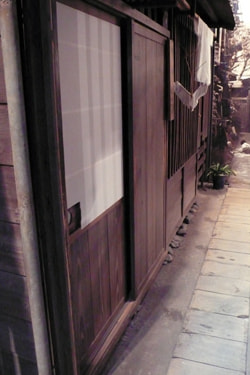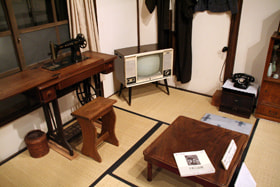A memory of nostalgic lives exits here.

You come across a variety of people in an alley beside the row house.
Ishii: We have never lived in the exhibition space. However, houses and rooms at that time are reproduced, and actual household appliances are placed there. There are many other museums which reproduce and exhibit houses and rooms in the same way, but most of them prohibit visitors to enter the exhibition spaces or place dolls in the spaces, so visitors have nothing else to do but see the exhibits objectively even if the exhibits are realistically reproduced. However, this museum do not have such restriction and do not place dolls in the exhibition space so that visitors can not only see the exhibits but also really experience and feel the exhibition space. Our policy is to exhibit a whole scene of lives at that time, including a street vendor's cry, ticking of a wall clock and shamisen's sound heard from a house across the street. Although I mentioned before that the Shitamachi area before the earthquake hit in the Taisho Period is reproduced, strictly speaking, the date indicated on the block calendar is today's date. The wall clock is also set. In the current exhibition, the lanterns with puns written on them are set because the first Horse Day is approaching. Visitors can feel that they happen to visit the museum at this hour on the same day in the Taisho Period. The exhibits on the first floor are reproduced as if people in the Taisho Period are still living there. Of course, household appliances at that time are placed there. [continued in the lower column]

Q: It might be interesting if there are passersby. People are not intentionally included in the exhibition, are they?
Ishii: Do you mean that staff members should wear clothes of those days? I think it might be a good attempt. As a similar attempt, all staff members wear happi coats.[continued in the upper right column]

Q: Do visitors call up their memories by looking at exhibits, which they saw or played with in their childhood?
Ishii: The range of visitors to this museum is very wide. It ranges from elementary school students to elderly people. Many foreign visitors have also visited the museum. Eleven to twelve percent of visitors are people from overseas. Of course, although the broad range of Japanese visitors and foreign visitors have entirely different impressions, strangely enough, junior high school and high school students say "nostalgic" when they see the exhibition set in the Taisho Period. They say it looks like their grandmothers' houses. As for elderly visitors, since the exhibition is set in the period before the earthquake and the living space is reproduced by placing a low sink in a one-story house, most of them must hardly experienced such a life, but "nostalgic" is the most common impression among them.
I think it is not very necessary for visitors that the year is strictly set in 1921. For example, if it is the Edo Period, it is the "history," which means that it is clearly remote from us. However, in an exhibition like this, the theme is a "memory" which visitors slightly feel nostalgic in some way, so it is not history. Young visitors might see the living space of the narrow row house, in which a Japanese-style chest of drawers, low dining table and charcoal brazier are placed, through their memories of old-time Japan, although they do not even experienced it. Except very young visitors, a wide age range of visitors have the same impression. Especially, many young visitors like university students feel nostalgic when they see the exhibition even though they did not actually experience the old life. This point differentiates our museum from other museums or local folk museums. I think they feel a sense of continuity, in which they are connected to the preceding era of Japan, through nostalgia other than interest in history.
Q: In general, people tend to distinguish a living culture from a public culture. I think, however, most cultures are living cultures.
Ishii: A teacher said that all things, except genetically-obtained ones, are cultures. In this sense, it has no limitation, but the term "living" might be more appropriate than "culture." [continued in the next page]

You come across a variety of people in an alley beside the row house.














